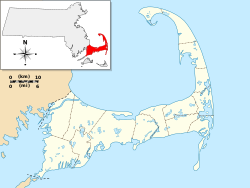Gifford Farm | |
 261 Cotuit Road | |
| Location | 261 Cotuit Road, Barnstable, Massachusetts |
|---|---|
| Coordinates | 41°39′26″N70°24′43″W / 41.65722°N 70.41194°W |
| Built | 1850 |
| Architectural style | Greek Revival |
| MPS | Barnstable MRA |
| NRHP reference No. | 87000245 [1] |
| Added to NRHP | March 13, 1987 |
The Gifford Farm is a historic farmhouse in Barnstable, Massachusetts. The 1+1⁄2-story Cape style house was built c. 1850, and is an unusual local instance of a double house. Rather than having five bays, a traditional Cape organization, it has a pair of entrances flanked by pairs of windows. The house was probably built by Russell Hinckley; it was a major social center in the early decades of the 20th century, when it was owned by Lorenzo Gifford. [2]
The house was listed on the National Register of Historic Places in 1987. [1]



